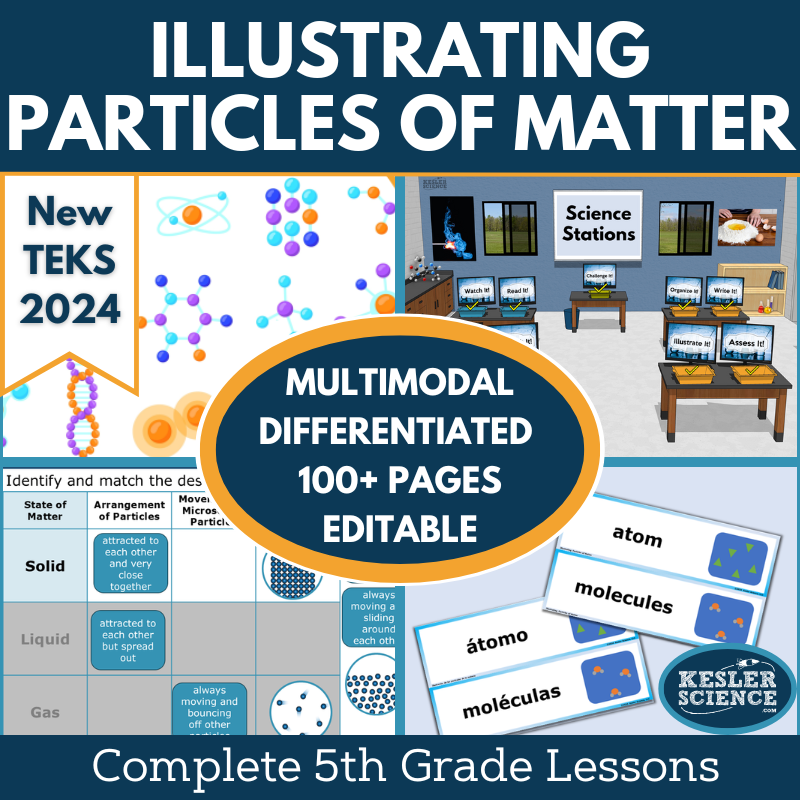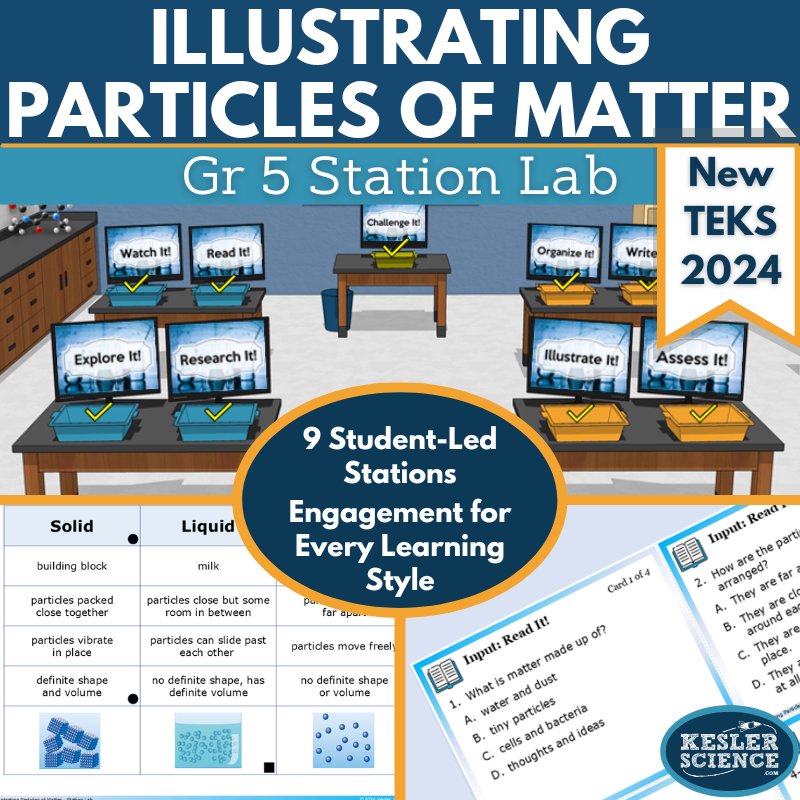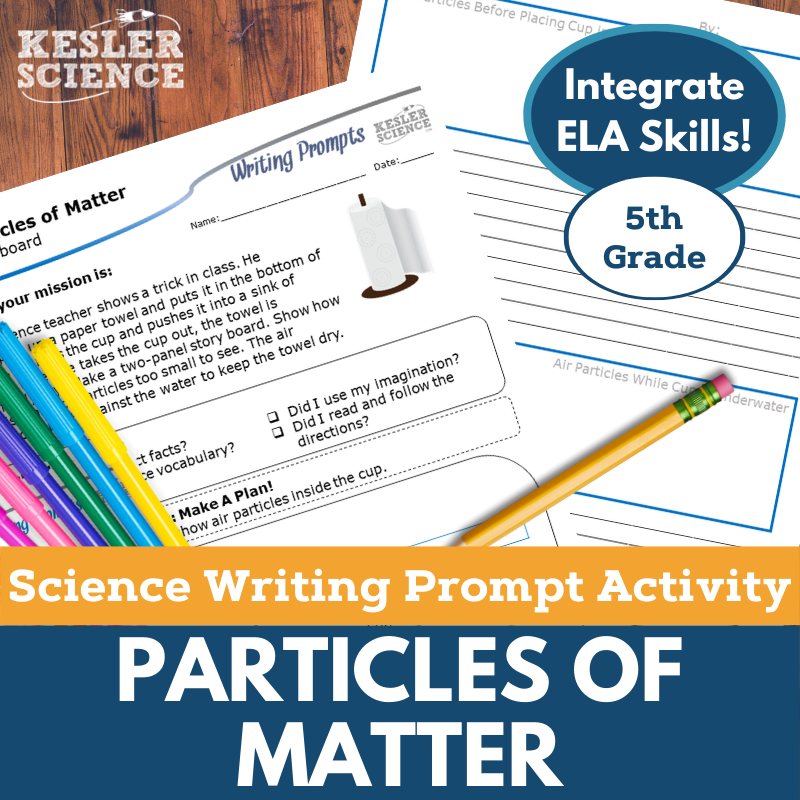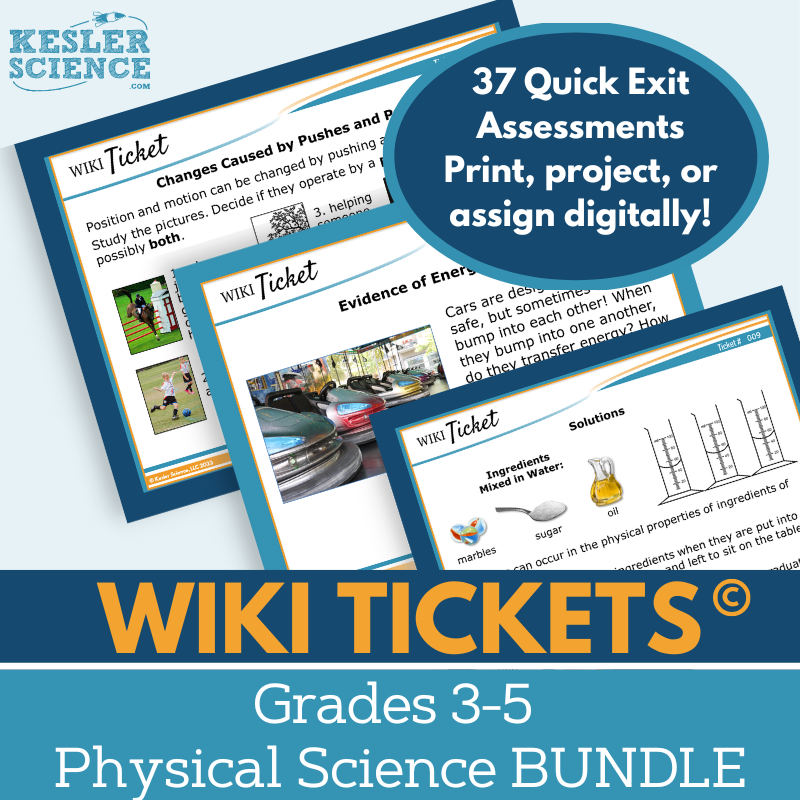Illustrating Particles of Matter Activities for 5th Grade Science
Help your 5th-grade students grasp the concept that matter is made of particles too small to see with this engaging 5E lesson aligned to TEKS 5.6D. The resources below will give students a comprehensive understanding of the particles of matter. All of the following materials are also included in the Kesler Science Membership.
The Kesler Science Illustrating Particles of Matter 5E Lesson is a comprehensive physical science unit designed to help 5th-grade students understand how matter is made up of particles too small to be seen, like air in a balloon. The lesson includes editable PowerPoints, worksheets, assessments, and student-choice projects for differentiated, student-led learning. It aligns with the 2021 TEKS 5.6D standard and is available in both digital and printable formats, with Spanish translations of key materials.
Following the 5E Model, the unit offers engaging activities, including a student-led station lab with nine stations that incorporate hands-on experiments, reading passages, research tasks, and videos. Students demonstrate their understanding through organizing, writing, illustrating, and assessment activities. Editable presentations and interactive notebook templates support explanation, while student-choice projects extend learning through creative demonstrations. Evaluation resources include STAAR 2.0-aligned assessments, review questions, and worksheets suitable for class discussions or homework. This flexible lesson is ideal for both in-person and virtual learning environments.
The Kesler Science Illustrating Particles of Matter 5E Lesson is a comprehensive physical science unit designed to help 5th-grade students understand how matter is made up of particles too small to be seen, like air in a balloon. The lesson includes editable PowerPoints, worksheets, assessments, and student-choice projects for differentiated, student-led learning. It aligns with the 2021 TEKS 5.6D standard and is available in both digital and printable formats, with Spanish translations of key materials.
Following the 5E Model, the unit offers engaging activities, including a student-led station lab with nine stations that incorporate hands-on experiments, reading passages, research tasks, and videos. Students demonstrate their understanding through organizing, writing, illustrating, and assessment activities. Editable presentations and interactive notebook templates support explanation, while student-choice projects extend learning through creative demonstrations. Evaluation resources include STAAR 2.0-aligned assessments, review questions, and worksheets suitable for class discussions or homework. This flexible lesson is ideal for both in-person and virtual learning environments.
Engage your 5th-grade students with this student-led station lab aligned with the 2021 TEKS 5.6D standard. Designed for in-class or virtual learning, this lesson guides students in illustrating how matter is made up of particles too small to be seen, exploring their arrangement in different phases through nine interactive stations.
Students encounter new concepts through activities like hands-on exploration, watching videos, reading passages (available in English and Spanish), and conducting research with facts, images, and graphs. They demonstrate their understanding by organizing information, drawing particle models, writing responses, and completing assessments. A bonus challenge station offers extension activities, including crosswords, games, and mini-projects.
This differentiated, student-centered resource promotes active learning, critical thinking, and allows students to direct their own learning, whether working independently or in small groups.
Engage your 5th-grade students with this student-led station lab aligned with the 2021 TEKS 5.6D standard. Designed for in-class or virtual learning, this lesson guides students in illustrating how matter is made up of particles too small to be seen, exploring their arrangement in different phases through nine interactive stations.
Students encounter new concepts through activities like hands-on exploration, watching videos, reading passages (available in English and Spanish), and conducting research with facts, images, and graphs. They demonstrate their understanding by organizing information, drawing particle models, writing responses, and completing assessments. A bonus challenge station offers extension activities, including crosswords, games, and mini-projects.
This differentiated, student-centered resource promotes active learning, critical thinking, and allows students to direct their own learning, whether working independently or in small groups.
The Illustrating Particles of Matter Student Choice Projects align with the 2021 TEKS chemistry standard 5.6D, giving 5th graders the opportunity to choose a project that suits their preferred output style. A project page outlines six student-led options and a “design your own” project, with an editable rubric for teacher, peer, or self-assessment. This resource is also part of the Illustrating Particles of Matter Complete Lesson for TEKS 5.6D.
These flexible, multimodal projects allow students to creatively demonstrate their understanding, and teachers can adjust the rubric to meet grading needs. Two versions of the project page support differentiation, offering modified options for students needing remediation and more challenging options for advanced learners.
The resource includes nine project choices plus a “design your own” option, a teacher directions page with guidance and suggestions, and editable rubric pages that assess vocabulary, concepts, presentation, clarity, and accuracy. Projects can be completed using standard classroom supplies like paper, markers, and scissors, with many options available for digital completion.
The Illustrating Particles of Matter Student Choice Projects align with the 2021 TEKS chemistry standard 5.6D, giving 5th graders the opportunity to choose a project that suits their preferred output style. A project page outlines six student-led options and a “design your own” project, with an editable rubric for teacher, peer, or self-assessment. This resource is also part of the Illustrating Particles of Matter Complete Lesson for TEKS 5.6D.
These flexible, multimodal projects allow students to creatively demonstrate their understanding, and teachers can adjust the rubric to meet grading needs. Two versions of the project page support differentiation, offering modified options for students needing remediation and more challenging options for advanced learners.
The resource includes nine project choices plus a “design your own” option, a teacher directions page with guidance and suggestions, and editable rubric pages that assess vocabulary, concepts, presentation, clarity, and accuracy. Projects can be completed using standard classroom supplies like paper, markers, and scissors, with many options available for digital completion.
The Particles of Matter Science and ELA Integrated Writing Activity engages 5th-grade students in exploring gas particles through a creative storyboard format. This standards-aligned resource, based on 5-PS1-1, encourages students to model how matter is made of particles too small to be seen. Designed for both in-person and virtual learning, it supports science reasoning, writing skills, and student engagement.
This low-prep, student-centered activity includes teacher directions with an answer guide, project ideas, and rubrics. It offers both projection and printable handouts, including full and half-sheet options for interactive notebooks. A digital PowerPoint version, compatible with Google Slides, allows for flexible assignment in-person or remotely.
Ideal for cross-curricular activities, pre-test assessments, student choice projects, early finisher tasks, extra credit, make-up work, TELPAS samples, or differentiation, this writing prompt fosters creativity and scientific understanding. Finished work can be displayed on bulletin boards or compiled into a student anthology. Designed for review, it assumes prior knowledge or access to research materials.
The Particles of Matter Science and ELA Integrated Writing Activity engages 5th-grade students in exploring gas particles through a creative storyboard format. This standards-aligned resource, based on 5-PS1-1, encourages students to model how matter is made of particles too small to be seen. Designed for both in-person and virtual learning, it supports science reasoning, writing skills, and student engagement.
This low-prep, student-centered activity includes teacher directions with an answer guide, project ideas, and rubrics. It offers both projection and printable handouts, including full and half-sheet options for interactive notebooks. A digital PowerPoint version, compatible with Google Slides, allows for flexible assignment in-person or remotely.
Ideal for cross-curricular activities, pre-test assessments, student choice projects, early finisher tasks, extra credit, make-up work, TELPAS samples, or differentiation, this writing prompt fosters creativity and scientific understanding. Finished work can be displayed on bulletin boards or compiled into a student anthology. Designed for review, it assumes prior knowledge or access to research materials.
WIKI Tickets© formative assessments are a fun and engaging way to check student understanding of physical science concepts for 3rd–5th grade. This set includes 37 assessments, each available in five formats: a full-screen projection version, three printable handout sizes, and an interactive digital version compatible with PowerPoint and Google Slides. Designed to align with NGSS and TEKS standards, every standard is covered with at least one ticket, and some topics include multiple assessments for deeper exploration. A helpful table of contents is also included to show the alignment with specific standards.
These assessments cover a wide range of topics, including forces and motion, forms and transfers of energy, states and properties of matter, electrical circuits, magnetism, gravity, and waves. Additional concepts such as conservation of mass, mixtures and solutions, reflection and refraction, and the sun’s energy are also addressed. WIKI Tickets© can be used as exit tickets, bellringers, or quick comprehension checks and are adaptable for in-person, 1:1 digital, or virtual learning environments. Whether projected, printed, or assigned digitally, they offer a flexible, ready-to-use tool for assessing student progress.
WIKI Tickets© formative assessments are a fun and engaging way to check student understanding of physical science concepts for 3rd–5th grade. This set includes 37 assessments, each available in five formats: a full-screen projection version, three printable handout sizes, and an interactive digital version compatible with PowerPoint and Google Slides. Designed to align with NGSS and TEKS standards, every standard is covered with at least one ticket, and some topics include multiple assessments for deeper exploration. A helpful table of contents is also included to show the alignment with specific standards.
These assessments cover a wide range of topics, including forces and motion, forms and transfers of energy, states and properties of matter, electrical circuits, magnetism, gravity, and waves. Additional concepts such as conservation of mass, mixtures and solutions, reflection and refraction, and the sun’s energy are also addressed. WIKI Tickets© can be used as exit tickets, bellringers, or quick comprehension checks and are adaptable for in-person, 1:1 digital, or virtual learning environments. Whether projected, printed, or assigned digitally, they offer a flexible, ready-to-use tool for assessing student progress.
Year-Round Resources
These year-round activities will increase your students' understanding of many middle school science topics. All of these activities are also included in the Kesler Science Membership.
Visual Data & Graphing
You're not alone if your students struggle with understanding graphs, charts, and tables. It's a skill that takes an enormous amount of practice. This resource will help students build a strong foundation in analyzing data and creating their own data visualizations.
Bell Ringers and Warm-Ups
These middle school science bell ringers are an excellent way to engage your students as soon as they walk into your classroom. This comprehensive FULL YEAR resource includes everything you need to start off each science class with an interesting warm-up activity.
Review Board Games
Each game board has been carefully designed to keep students engaged. There are 10 different action spaces on each board and dozens of question cards. All of the actions are related to science concepts and keep the students motivated throughout the game.
Each game is ready to play. Simply print out the board and the cards and let the students enjoy reviewing nine different units.
Essential Questions and Standards
Below are the essential questions and standards associated with the lessons and activities included in the atoms unit. This topic is only one of more than 100 middle school science topics included in the Kesler Science Membership.
-
How do we illustrate that matter is made up of particles that are too small to be seen?
-
TEKS Science - 5.6D Illustrating Particles of Matter
Kesler Science Membership
Imagine never having to search for another middle school science lesson again. The membership gives you access to ALL of the Kesler Science products in one place (Yes, including everything above).
Say goodbye to long hours of lesson prep.











